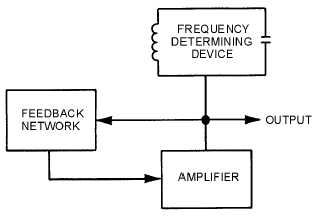2-6
Figure 2-4 shows a block diagram of a typical LC oscillator. Notice that the oscillator contains the
three basic requirements for sustained oscillations: amplification, a frequency-determining device, and
regenerative feedback.
Figure 2-4.—LC oscillator.
The amplifier supplies energy to begin what is known as the FLYWHEEL EFFECT. The flywheel
effect is the maintenance of oscillations in a circuit in the intervals between pulses of excitation energy.
Recall that in chapter 1 the tank circuit alternately stored energy in the inductor and capacitor. The LC
network provides initial oscillations. A portion of the output of the LC network is then returned to the
input of the amplifier through the regenerative-feedback network to sustain the oscillations.
When a tank circuit is used to develop oscillations in an oscillator, the output frequency of the
oscillator is primarily the resonant frequency of the tank circuit and can be found by the formula:
Crystals
Another frequency-determining device is the CRYSTAL. The crystal may be used with a tank
circuit, or it may perform alone. Crystals exhibit a characteristic known as the PIEZOELECTRIC
EFFECT. The piezoelectric effect is the property of a crystal by which mechanical forces produce
electrical charges and, conversely, electrical charges produce mechanical forces. This effect is a form of
oscillation similar to the flywheel effect of a tank circuit.
The piezoelectric effect can be seen in a number of crystal substances. The most important of these
are the minerals quartz and Rochelle salt. Although quartz does not exhibit the piezoelectric effect to the
degree that Rochelle salt does, quartz is used for frequency control in oscillators because of its greater
mechanical strength. Another mineral, tourmaline, is physically strong like quartz; but because it is more
expensive, it is not used extensively as an fdd. This discussion will deal only with the quartz crystal.
The crystals used in oscillator circuits are thin sheets, or wafers, cut from natural or synthetic quartz
and ground to a specific thickness to obtain the desired resonant frequency. The crystals are mounted in
holders, which support them physically and provide electrodes by which voltage is applied. The holder
must allow the crystals freedom for vibration. There are many different types of holders. One type is
shown in figure 2-5.

